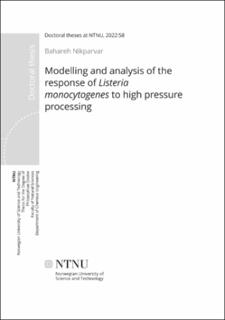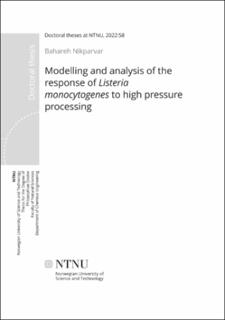| dc.contributor.advisor | Bar, Nadav | |
| dc.contributor.advisor | Skogestad, Sigurd | |
| dc.contributor.author | Nikparvar, Bahareh | |
| dc.date.accessioned | 2022-03-02T07:57:07Z | |
| dc.date.available | 2022-03-02T07:57:07Z | |
| dc.date.issued | 2022 | |
| dc.identifier.isbn | 978-82-326-5411-6 | |
| dc.identifier.issn | 2703-8084 | |
| dc.identifier.uri | https://hdl.handle.net/11250/2982267 | |
| dc.description.abstract | The effects of environmental stresses on microorganisms have been well-studied, and cellular responses to stresses such as heat, cold, acids, and salts have been extensively discussed. Some previous works studied the membrane, protein system, and DNA as susceptible structures in bacteria to external stress. Although high pressure processing (HPP) is an emerging technology as a preservation method in the food industry, the dynamics of the response of bacteria and particularly Listeria monocytogenes as a foodborne pathogen to high pressure processing (HPP) has not been well-explored yet. L. monocytogenes is known to survive extreme conditions, including high pressure, and therefore gaining knowledge of its reaction to the stress produced by high pressure may help the food industry to increase the efficiency of HPP. In this Ph.D. thesis, we employed synergy between various experimental techniques and modelling strategies to explore the cellular response of L. monocytogenes to HPP.
First, we found that high pressure stress could create membrane pores in L. monocytogenes after HPP at 400 MPa, 8 min. Using a common staining technique with propidium iodide (PI) combined with high-frequency fluorescence microscopy, we monitored the diffusion rate of PI molecules into hundreds of bacterial cells through these pores during four days after HPP. We found that the diffusion rate of PI into the cells decreased over the four consecutive days after exposure to HPP, indicating the existence of a repair mechanism for the pressure-created membrane pores. In addition, we developed a mathematical model based on mass transfer and passive diffusion laws, calibrated using our experimental data, to evaluate the rate of repair of the membrane following HPP. The model predicted a temporal change in the size of pores until closure. To the best of our knowledge, this is the first time that pressure-created membrane pores have been quantitatively described and shown to diminish with time. In addition, we found that the membrane repair rate in response to HPP was linear (at pore sizes < 20 nm), and growth was temporarily arrested at the population level during the repair period. Second, we used time-series RNA-seq transcriptome data of L. monocytogenes (ScottA) treated at 400 MPa for 8 min and combined it with current information in the literature to create a transcriptional regulation database, depicting the relationship between transcription factors (TFs) and their target genes (TGs) in L. monocytogenes. We then applied network component analysis (NCA), a matrix decomposition method, to reconstruct the activities of TFs over time. According to our findings, L. monocytogenes responded to the stress applied during HPP by three significantly different gene regulation modes: a survival mode during the first 10 min post-treatment, a repair mode during one hour post-treatment, and a re-growth mode beyond six hours after HPP. We identified the TFs and their TGs that were responsible for each of the modes. Third, since the SOS response and the chaperonin systems were shown to be essential regulatory networks that counteract environmental stresses, we developed a mathematical model to get a deeper insight into the behavior and dynamics of these two networks as parts of an initial recovery process in response to HPP. The model was described by a system of ordinary differential equations (ODEs) and calibrated using a time-series RNA-seq data to estimate critical parameters. Our model outputs indicated the existence of a range of parameters that yielded damped oscillatory behavior in the time response of the SOS response-associated variables. This is in contrast to the chaperonin system-related variables that showed a single pulse response to HPP. We found that perturbing the parameters associated with HU, a histone-like protein involved in activation of RecA (a regulator of the SOS response), and consequently induction of the SOS response, had significant impacts on the characteristics of the response. Moreover, our results suggested a correlation between the frequency of oscillations of the SOS response and the resistibility of RO15 and ScottA (two strains of L. monocytogenes) to HPP. Additionally, our further analysis led us to formulate a hypothesis about the relationship between HPP parameters (pressure value and holding time) and the characteristics of oscillations in the SOS response. We believe that these results may guide the industry to adjust different parameters of HPP to achieve a more efficient preservation technology via pressurization. | en_US |
| dc.language.iso | eng | en_US |
| dc.publisher | NTNU | en_US |
| dc.relation.ispartofseries | Doctoral theses at NTNU;2022:58 | |
| dc.relation.haspart | Nikparvar, Bahareh; Subires, Alicia; Capellas, Marta; Hernandez, Manuela; Bar, Nadav.
A Dynamic Model of Membrane Recovery Mechanisms in Bacteria following High Pressure Processing. IFAC-PapersOnLine 2019 ;Volum 52.(1) s. 243-250 https://doi.org/10.1016/j.ifacol.2019.06.069 | |
| dc.relation.haspart | Nikparvar, Bahareh; Andreevskaya, Margarita; Duru, Ilhan C.; Bucur, Florentina I.; Leontina, Grigore-Gurgu; Borda, Daniela; Nicolau, Anca I.; Riedel, Christian U.; Auvinen, Petri; Bar, Nadav.
Analysis of temporal gene regulation of Listeria monocytogenes revealed distinct regulatory response modes after exposure to high pressure processing. BMC Genomics 2021 ;Volum 22.(266)
https://doi.org/10.1186/s12864-021-07461-0
This article is licensed under a Creative Commons Attribution 4.0 International License (CC BY 4.0) | |
| dc.relation.haspart | Nikparvar, Bahareh; Duru, Ilhan C.; Auvinen, Petri; Riedel, Christian U.; Bar, Nadav.
Modelling the SOS response and chaperonin
system regulation as an early response of Listeria
monocytogenes to high pressure processing | |
| dc.title | Modelling and analysis of the response of Listeria monocytogenes to high pressure processing | en_US |
| dc.type | Doctoral thesis | en_US |
| dc.subject.nsi | VDP::Technology: 500::Mechanical engineering: 570 | en_US |

